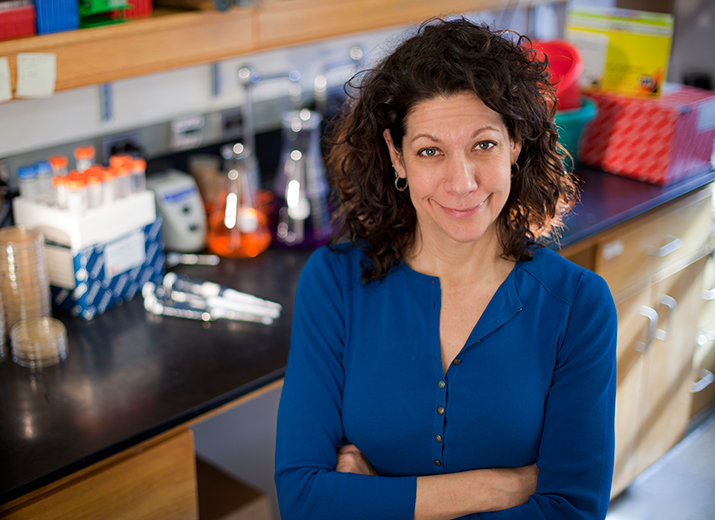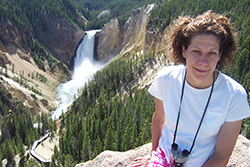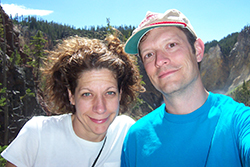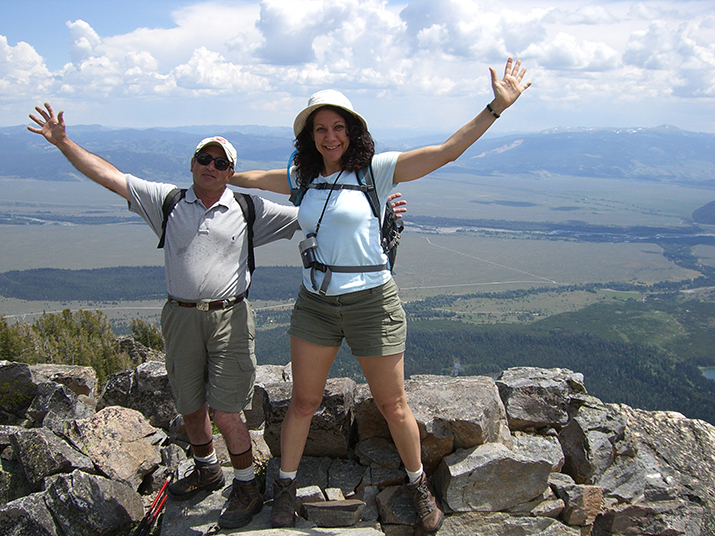Something to talk about: Bonnie Bassler
Bonnie L. Bassler will give a plenary lecture at the American Society for Biochemistry and Molecular Biology annual meeting in Boston. She will present her lecture, titled “Manipulating quorum sensing to control bacterial pathogenicity,” at 8 a.m. Sunday, March 29, in Ballroom West, on the third level of the Boston Convention & Exhibition Center.
Bonnie l. Bassler’s exuberance and energy are hard to miss, even over the phone. “I like being the center of attention,” says the quorum-sensing expert at Princeton University.

Bassler has been at the center of attention since 2002, when she received a MacArthur Foundation fellowship, also known as the “genius award.” The recognition came for her work on the intricate communication systems used by bacteria, known as quorum sensing. Since then, Bassler has had a spotlight on her. She has been profiled by major news outlets and gave a TED talk in 2009, the video of which has accumulated almost 2 million views.
For all her gregariousness, it comes as a surprise to hear Bassler’s postdoctoral adviser say his first impression of his protégé was “shy” and “quiet.” Michael Silverman took on Bassler as one of his last postdoctoral fellows before he retired from science. Bassler says she owes her career to him.
Luck and generosity

Bassler was lucky to meet Silverman 26 years ago. Silverman was an elusive figure among microbiologists. He was known for his work at the forefront of bacterial genetics — for example, as a graduate student, he made the seminal discovery that bacterial flagella have rotary motors. But Silverman hated public speaking, so not many people got to meet him at meetings and conferences.
However, in 1989, Silverman made an exception. He accepted an invitation to speak at a symposium in Baltimore. At that time, Silverman was studying an obscure marine bacterium called Vibrio fischeri, which glows in the dark. The bioluminescent bacterium relies on quorum sensing to produce its light-emitting molecules.
During his lecture, he described the genetic components he was untangling to figure out how the bacterium chatted with its brethren to determine when they should turn on their glow-in-the-dark molecules. Bassler was in the audience during this lecture. At this time, she was a graduate student at The Johns Hopkins University in Baltimore working under Saul Roseman on the biochemistry of bacterial chemotaxis toward a food source of carbohydrates.
Bassler didn’t know much about genetics, so she had trouble following the details of Silverman’s talk. But she grasped the big-picture concept — bacteria communicate and do something as a group. They aren’t solitary or silent. The idea of bacterial chitchat gripped Bassler’s imagination so much that she approached Silverman for a postdoctoral stint, to which he agreed.
Once she completed her Ph.D., Bassler packed her bags and her cat and headed to Silverman’s laboratory at the Agouron Institute in La Jolla, Calif., in 1990. Silverman’s team was small. At the time Bassler joined, it was just Silverman, a postdoctoral fellow and two technicians. “One of our most powerful tools was a sterile toothpick,” says Silverman with amusement. They used the sterile toothpicks to pluck off bacterial colonies from the plates of agar to create large arrays of mutant bacteria to manipulate and test under different conditions.
Into this world entered Bassler. “I was this card-carrying biochemist. I went to his lab, and the pH meter barely functioned. It was a lab filled with toothpicks. That was it. I didn’t know what the heck I was doing. I had never cloned a gene. I didn’t know what a promoter was. I didn’t know what a transposon was, and he’d be like, ‘Let’s do transposon mutagenesis,’” recalls Bassler. “I was so scared of him thinking I was stupid.”
She was so terrified of him that when a coyote killed her cat a few weeks after she moved to California, she refused to let the loss stop her. “I didn’t want to take days off, because I wanted to show him I was a hard worker,” she recalls. “I would just come and cry into my Petri plates.”
Bassler’s doggedness soon paid off. Silverman clearly remembers the day when, in his eyes, she came into her own as an independent researcher with her distinctive assertiveness. “She came into my office and wanted to talk to me,” says Silverman. “She said she thought she had learned a lot and she wanted to take over the project she was working on. I guess it surprised me how confident she was.”
Silverman, who believes in giving people room to test their wings, agreed. Bassler points to moments like this with Silverman as examples of his generosity. He gave his trainees the freedom to explore and take complete ownership of their work, which in Bassler’s case was another marine bioluminescent bacterium called Vibrio harveyi.
V. harveyi caused Bassler a lot of grief during her postdoctoral training: She couldn’t make mutants of the bacterium that were deficient in quorum sensing. Silverman already had made mutants of V. fischeri by knocking out the enzyme LuxI, which makes autoinducer 1, a quorum-sensing molecule, and LuxR, its receptor.
But first sets of V. harveyi mutants that Bassler made kept up with their quorum sensing. After a lot of frustration at being outwitted by a single-cell organism, Bassler realized that the V. harveyi must have two communication systems, not one. The mutants she was making were defective only in one communication system so they kept on talking to each other with the other system. This led her to propose that V. harveyi had an autoinducer-1 and an autoinducer-2, two different molecules that allow bacterial species to chat with each other.
During Bassler’s postdoctoral stay with Silverman, she also learned the business of running a laboratory. Because it was a small lab, Bassler says, she learned what it was like to be an independent investigator even before she got a faculty position. “It was the best practice for being a young professor. I ordered everything, I racked all the tips, I thought of all the experiments, I wrote my papers with him,” she explains. “But also, because he hated traveling, I gave every talk that he was ever invited to give.” Bassler says she remembers people asking her at these talks if Silverman even really existed.
When it came time for her to be an independent investigator at Princeton University, Bassler was the recipient of Silverman’s generosity again. “I had an unusual policy for science, which is I let the postdocs take their projects with them,” he says. “How are they going to make a living if they have to go out and start anew and compete with their old colleagues?”
In 1994, Bassler headed back to the East Coast to set up her laboratory with a research focus on V. harveyi (which she now unabashedly calls her favorite bug). A year later, Silverman retired from science and moved with his wife to Wyoming.
Mind-opening moments

Back in the 1990s, scientists didn’t view Bassler’s V. harveyi as a treasure trove of biological discoveries. Bacterial communication was seen as a quirk limited to V. fischeri and V. harveyi. Funding agencies weren’t clamoring to support work on cute but obscure glowing marine bacteria.
Bassler has told the tale of how her laboratory survived without much federal research funding, relying heavily on Princeton’s support. In 2006, she told The Scientist magazine, “This lab was held together with chewing gum and rubber bands for the first 10 years.”
Then the MacArthur award happened in 2002. The awards are five-year fellowships given out annually to 20 to 30 individuals by the MacArthur Foundation. According to the foundation’s website, “There are three criteria for selection of Fellows: exceptional creativity, promise for important future advances based on a track record of significant accomplishment, and potential for the fellowship to facilitate subsequent creative work.”
For Bassler, the award changed how everyone viewed her offbeat research. “It was a validation of my lab’s work as well as that of the entire field,” says Bassler, who is also a Howard Hughes Medical Institution investigator and a member of the National Academy of Sciences. Quorum sensing was no longer quirky.
By 2002, Bassler’s group isolated autoinducer 2, a molecule that allows bacterial species to chat with each other. Her group went on to show that bacteria related to V. harveyi (including Vibrio cholera, which causes cholera) also relied on the autoinducer 1 and 2 systems to communicate.
To find the enzyme that made autoinducer 2, Bassler’s group embarked on a gene hunt. They found one called luxS. LuxS, when they looked closer, was broadly conserved in the bacterial world. Bassler’s team went on to show that LuxS’ ubiquity was because the autoinducer-2 system was the way bacteria chatted across different species, almost like a universal language. Bassler has described it as Esperanto for bacteria.
>Bassler’s group doesn’t stop at the genes. They delve into the structural biology of the proteins made by the genes. They figure out how these communication molecules bind to their receptors and then, using molecular and biochemical tools, work out how the binding triggers signaling cascades. These signaling cascades tell the bacteria to glow, make toxins, or do whatever it is they need to do to survive and flourish as communities.
Based on what they discover about the quorum-sensing molecules, Bassler’s team also is developing inhibitors of the quorum-sensing system. The inhibitors are useful on two fronts: They can be used to discover more about the cogs and wheels of the quorum-sensing machinery and have the potential to be used as antibacterial agents.
This type of “follow that molecule” research has led the Bassler group into the RNA arena, because they discovered that small RNAs, rather like eukaryotic microRNAs, work as switches to control the bacteria’s entry and exit into quorum-sensing mode. “We always knew there was a missing component” that made sure that hundreds of genes “turn on and off in the right order at the right time,” says Bassler, adding that these RNAs “allow more versatility than proteins: lower noise, higher robustness, more rapid quorum-sensing transition rates.”>
Figuring out that small RNAs are a critical component in quorum sensing was “a mind-opening moment,” notes Bassler. “We’re so biased about thinking that proteins run the show.”

Communication as a part of scholarship
Mind-opening moments drive Bassler as a scientist. “At your core, the reason why you’re in this business is because you’re curious,” she states. “That’s the main reason.” This type of curiosity — the deep, probing and relentless kind — is what Silverman says sets Bassler apart from other people as a scientist.
Figuring out what bacteria have developed for their evolution and survival is the quest, says Bassler, who is the current chair of the molecular biology department at Princeton. “It’s you against the bacterium. That’s the competition … Can you trick this bacterium into giving up its secrets?” Then, within a beat, she adds with a hoot of laughter, “Guess who’s not winning?”
With her passion to discover the unknown, Bassler can’t fathom how some people don’t find science to be awe-inspiring. “I can’t understand when people think it’s boring, hard or not relevant,” she says and doesn’t hold back on her views of science phobia and science illiteracy. “We have a huge problem in this country where people don’t like science, don’t think it helps their lives be better, and don’t believe in data as a way of making decisions,” she says. “This is unfortunate.”
But Bassler isn’t the kind to walk away from the problem. She sees science communication as central to her scholarship and puts a lot of time and effort into her lectures by rehearsing them, making sure her slides make concise and clear points, and weaving the points together to make a good story.
“I believe you don’t have to be boring to deliver content,” says Bassler, who also teaches aerobics and has done so for 32 years. “You can be funny, you can be excited, and you can be easy to understand.”
Bassler, who will be a plenary lecturer at the American Society for Biochemistry and Molecular Biology’s annual meeting next month, knows firsthand how a lecture can change someone’s worldview. After all, her career got its jumpstart by the fateful talk Silverman gave in 1989 when she says “I was mesmerized and awestruck.”
Enjoy reading ASBMB Today?
Become a member to receive the print edition four times a year and the digital edition monthly.
Learn moreGet the latest from ASBMB Today
Enter your email address, and we’ll send you a weekly email with recent articles, interviews and more.
Latest in People
People highlights or most popular articles

Building a stronger future for research funding
Hear from Eric Gascho of the Coalition for Health Funding about federal public health investments, the value of collaboration and how scientists can help shape the future of research funding.

Fueling healthier aging, connecting metabolism stress and time
Biochemist Melanie McReynolds investigates how metabolism and stress shape the aging process. Her research on NAD+, a molecule central to cellular energy, reveals how maintaining its balance could promote healthier, longer lives.

Mapping proteins, one side chain at a time
Roland Dunbrack Jr. will receive the ASBMB DeLano Award for Computational Biosciences at the ASBMB Annual Meeting, March 7–10, just outside of Washington, D.C.

2026 voter guide
Learn about the candidates running for Treasurer-elect, Councilor and Nominating Committee.

Meet the editor-in-chief of ASBMB’s new journal, IBMB
Benjamin Garcia will head ASBMB’s new journal, Insights in Biochemistry and Molecular Biology, which will launch in early 2026.

Exploring the link between lipids and longevity
Meng Wang will present her work on metabolism and aging at the ASBMB Annual Meeting, March 7-10, just outside of Washington, D.C.

